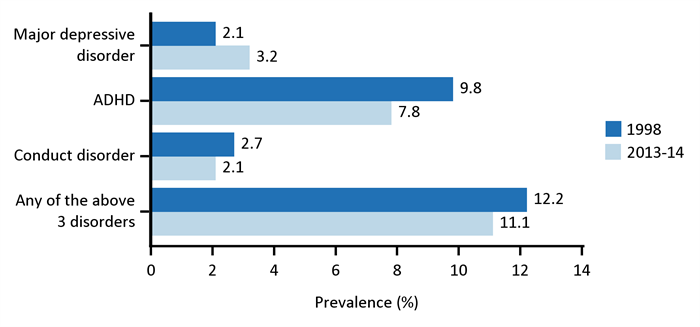Comparisons between the first and second surveys
The first national survey of the mental health of children and adolescents was undertaken in 1998. This produced the first evidence of the prevalence of mental disorders in Australian young people and their use of services for these problems. While the second survey has the same focus and was designed to enable comparisons to be made, there are some significant differences in the mental disorders assessed, and the service use timeframe and scope.
Prevalence of disorders
-
- The DISC-IV was used in both the first and second surveys to assess whether young people had mental disorders according to the standard DSM-IV diagnostic criteria.
- In 1998 major depressive disorder, dysthymic disorder, attention-deficit/hyperactivity disorder, conduct disorder and eating disorders were assessed.
- In 2013-14 the dysthymic and eating disorders modules were not included, as the prevalences for these were found to be too low for reporting in 1998.
- Four types of anxiety disorder (social phobia, separation anxiety, generalised anxiety and obsessive-compulsive disorder) were also included in 2013-14. These were found to affect 6.9% of children and adolescents, with the majority only experiencing anxiety disorders. This has a significant impact on comparisons between surveys of the overall prevalence of mental disorders.
- Comparison of prevalence data from 1998 and 2013-14 did not reveal a great deal of change overall, however, there were significant changes in the prevalence of each of those mental disorders covered by both surveys.
- The prevalence of major depressive disorder increased from 2.1% to 3.2% in 2013-14.
- The prevalence of ADHD decreased from 9.8% to 7.8%.
- Conduct disorder decreased slightly from 2.7% to 2.1%.
Service use
-
- The service use module was redesigned for the second survey, both to ensure its relevance to the current mental health care environment, particularly the development of online information and services, and to better capture the role of schools in providing services, referrals and support.
- The first survey produced evidence of service use in the previous 6 months, and found that only 31.2% of 6-17 year olds with mental disorders used services in 1998. By contrast the second survey found 68.3% of this population used services, but this was measured over a 12-month period.
- While differences in survey content and time periods covered make comparisons difficult, the increase in use of services is higher than is likely to be attributable to changes in methodology alone. On balance, the data suggest that there has been a significant increase in service use by children and adolescents with mental disorders in Australia between 1998 and 2013-14.
12-month prevalence of selected mental disorders among 6-17 year-olds in 1998 and 2013-14

Search the findings
More information about the survey findings can be accessed through the interactive Survey Results Query Tool.
Access the tool